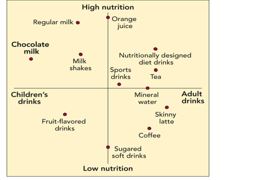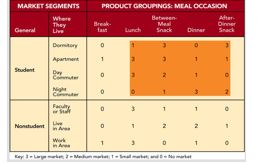A) demographic
B) behavioral
C) economic
D) geographic
E) psychographic
G) C) and D)
Correct Answer

verified
Correct Answer
verified
Multiple Choice
Hallmark placed its scrapbook supplies,photo albums,and related supplies into one product group because
A) it was easier to forecast future sales since there were fewer market-product combinations.
B) customers could buy in quantity and take advantage of quantity discounts.
C) their suppliers provided free displays and shelving to highlight Hallmark's products.
D) it helped buyers relate to the products and make decisions in a more meaningful way.
E) it allowed customers to compare price and quality with competitors who displayed their products in a similar manner.
G) B) and E)
Correct Answer

verified
Correct Answer
verified
Multiple Choice
Which of these is collected from consumers to develop a product's perceptual map?
A) consumer judgments about the important attributes for a product or brand class
B) a listing of all prospective brands and products
C) managerial judgments about how consumers perceive products
D) rank order of the ratings of an existing brand's preference relative to its competitors
E) detailed explanations of why consumers make the choices they do
G) A) and B)
Correct Answer

verified
Correct Answer
verified
Multiple Choice
Market segmentation stresses __________ and relating them to specific marketing actions.
A) aligning tasks to match competitor tactics
B) grouping people according to similar needs
C) dividing people within a market randomly into equally sized groups
D) dividing people into the smallest groups possible
E) identifying potential new buyers who are not yet familiar with a new product
G) A) and C)
Correct Answer

verified
Correct Answer
verified
Multiple Choice
Suppose marketers want to use product differentiation and market segmentation strategies.What question should they ask when considering the potential for cannibalization with these strategies?
A) Will our new products steal customers or sales from our older ones?
B) Will the products compete head-to-head with those of a competitor?
C) Can this action successfully draw customers away from competitors?
D) Are there enough similarities within the market segment to warrant such high costs?
E) Will this action eliminate the need for individualized advertising and promotion?
G) A) and C)
Correct Answer

verified
Correct Answer
verified
Multiple Choice
Behavioral segmentation may be based on
A) lifestyles and demographics.
B) retailer and wholesaler behaviors.
C) geographic and demographic criteria.
D) product features and retail store type.
E) demand and supply.
G) None of the above
Correct Answer

verified
Correct Answer
verified
Multiple Choice
When a new product or a new retail chain steals customers and sales from the organization's older products and retail outlets,it is referred to as
A) cannibalization.
B) amortization.
C) product appropriation.
D) product pilfering.
E) marketing Darwinism.
G) B) and E)
Correct Answer

verified
Correct Answer
verified
Multiple Choice
Which of the following is a criterion used for selecting a target segment?
A) potential for increased profit
B) competitive position
C) similarity of needs of potential buyers within a segment
D) difference of needs of buyers among segments
E) potential of a marketing action to reach a segment
G) B) and C)
Correct Answer

verified
Correct Answer
verified
Multiple Choice
Today,marketers are increasingly emphasizing a Tiffany/Walmart strategy,which is to offer
A) a low-priced product to a high-income or high net worth segment.
B) a high-priced product to a low-income or low net worth segment.
C) different variations of the same basic offering to high-end and low-end segments.
D) a high-priced and a low-priced offering to a single market segment.
E) entirely different offerings to high-end and low-end segments.
G) None of the above
Correct Answer

verified
Correct Answer
verified
Multiple Choice
Many companies have cut travel budgets so that very few businesspeople are authorized to fly first class.Despite the shrinking pool of business-class travelers,British Airways has grown market share for its trans-Atlantic business class by offering greater comfort.Promotions to frequent fliers stress that passengers can sleep in fully reclining seats and arrive refreshed to carry out a full day's schedule.The segmentation strategy of British Airways is an example of
A) life stage segmentation.
B) geographic segmentation.
C) social class segmentation.
D) behavioral segmentation.
E) psychographic segmentation.
G) A) and B)
Correct Answer

verified
Correct Answer
verified
Multiple Choice
Todd Harris and Associates,a New York sales promotion agency,discovered from an analysis of its files that one-quarter (or 25 percent) of its clients generated more than three-quarters (or 75 percent) of its fees and commissions.This is an example of what classic concept?
A) the two quarter gap
B) the 80/20 rule
C) the law of usage
D) the 75/25 exchange
E) Paget's Law
G) A) and C)
Correct Answer

verified
Correct Answer
verified
Multiple Choice
The O3 technology refers to an innovative tennis racquet Prince Sports developed that simultaneously delivers faster racquet speed and a bigger sweet spot in the middle of the frame.Prince Sports has implemented a __________ strategy with its O3 innovative tennis racquet technology.
A) competitive segmentation
B) head-to-head
C) product differentiation
D) usage segmentation
E) market segmentation
G) A) and B)
Correct Answer

verified
Correct Answer
verified
Multiple Choice
Figure 8-8  -The perceptual map in Figure 8-8 shows adult perceptions for beverages.Suppose a marketer is introducing a new beverage that is higher-than-average in nutrition and is intended for adults.It will probably be most useful to promote the drink as similar to what?
-The perceptual map in Figure 8-8 shows adult perceptions for beverages.Suppose a marketer is introducing a new beverage that is higher-than-average in nutrition and is intended for adults.It will probably be most useful to promote the drink as similar to what?
A) tea
B) fruit-flavored drinks
C) sugared soft drinks
D) regular milk
E) coffee
G) A) and E)
Correct Answer

verified
Correct Answer
verified
Multiple Choice
Four general categories are used to segment consumer markets.Which of these is one of them?
A) supplier segmentation
B) demand segmentation
C) industry segmentation
D) behavioral segmentation
E) product segmentation
G) A) and C)
Correct Answer

verified
Correct Answer
verified
Multiple Choice
Product differentiation refers to
A) a good, service, or idea consisting of a bundle of tangible and intangible attributes that satisfies consumers' needs.
B) the unique combination of product benefits received by targeted buyers.
C) those characteristics of a product that make it superior to competitive substitutes.
D) a marketing strategy that involves a firm using different marketing mix actions to help consumers perceive the product as being different and better than competing products.
E) the legal requirement that requires a specified degree of distinction between products to ensure an organization's intellectual property rights.
G) B) and E)
Correct Answer

verified
Correct Answer
verified
Multiple Choice
Recently,U.S.dairies,struggling to increase milk sales,tried to change the way adults thought about chocolate milk.The dairies wanted to __________ chocolate milk in the minds of adult consumers.
A) segment
B) differentiate
C) explain
D) promote
E) reposition
G) C) and D)
Correct Answer

verified
Correct Answer
verified
Multiple Choice
Figure 8-6  -Figure 8-6 shows the market-product grid for a Wendy's restaurant next to a large urban university campus.The best way to describe how the student market is segmented is
-Figure 8-6 shows the market-product grid for a Wendy's restaurant next to a large urban university campus.The best way to describe how the student market is segmented is
A) whether the student is a faculty or staff member.
B) whether the student lives near the campus or far away.
C) whether the student has the disposable income to eat at Wendy's.
D) combining where the student lives, if on campus, or what time the student commutes.
E) the meals eaten at the Wendy's restaurant.
G) D) and E)
Correct Answer

verified
Correct Answer
verified
Multiple Choice
The segmentation strategy used by Prince Sports today is
A) geographic.
B) behavioral.
C) psychographic.
D) socioeconomic.
E) resource-based.
G) B) and D)
Correct Answer

verified
Correct Answer
verified
Multiple Choice
Nike employs a __________ strategy at its website,nikeid.com,which allows customers to design a sneaker to their own personal specifications.
A) product sampling
B) product clustering
C) mass customization
D) usage segmentation
E) psychographic segmentation
G) B) and C)
Correct Answer

verified
Correct Answer
verified
Multiple Choice
When considering the quick-service restaurant competition,it will be most important for Wendy's to consider not only the offerings of Burger King,McDonald's,Five Guys,and other hamburger chains but also the
A) meals at golf and country clubs.
B) dormitory meal plans at surrounding colleges and universities.
C) items for sale at gas stations and convenience stores.
D) local farmer's markets that sell produce.
E) nearly every food item sold at local grocery stores.
G) A) and B)
Correct Answer

verified
Correct Answer
verified
Showing 181 - 200 of 201
Related Exams